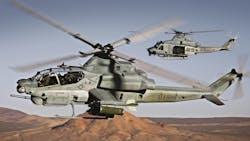Navy asks Northrop Grumman to provide networking data link for Marine Corps attack and utility helicopters
PATUXENT RIVER NAS, Md. – Northrop Grumman Corp. avionics experts will provide U.S. Marine Corps combat helicopters with additional sensor networking capability under terms of a $24.3 million order announced late last month.
Officials of the U.S. Naval Air Systems Command at Patuxent River Naval Air Station, Md., are asking the Northrop Grumman Mission Systems segment in Woodland Hills, Calif., for 25 Link 16 production B kits, three Link 16 B kit spares, and two Link 16 flight training device B kits for UH-1Y and AH-1Z helicopters.
Link 16 is a military tactical data link network used by the U.S. military and its NATO allies that enables military aircraft, ships, and ground forces to exchange their tactical picture in near-real time. Link 16 also supports the exchange of text, imagery, and digital voice messages.
The AH-1Z Viper is a twin-engine attack helicopter based on the AH-1W SuperCobra that features a four-blade rotor system, uprated transmission, and a new target sighting system. It has upgraded avionics, weapons, and electro-optical sensors designed to find targets at long ranges and attack them with precision weapons.
The UH-1Y Venom helicopter -- also called the Super Huey -- is a twin-engined, medium-sized utility helicopter designed to replace the U.S. Marine Corps UH-1N Twin Huey light utility helicopters, first introduced in the early 1970s.
Link 16 is based on time-division multiple access (TDMA) communications technology, and is a secure, jam-resistant, high-speed digital data link that operates at RF and microwave frequencies from 960 to 1,215 MHz.
This frequency range limits information exchange directly to line-of-sight distances, although satellite communications (SATCOM) and ad-hoc protocols can pass Link 16 data over long-haul protocols such as TCP/IP using MIL-STD 3011 (JREAP) or STANAG 5602 (SIMPLE). Information typically passes at rates of 31.6, 57.6, or 115.2 kilobits per second.
The AH-1Z and UH-1Y are party of the Marine Corps H-1 upgrades program to build new helicopters, as well as rebuilding legacy AH-1W SuperCobra attack helicopters and UH-1N Twin Huey utility helicopters with state of the art designs. The program seeks to upgrade AH-1Ws to AH-1Zs, and UH-1Ns to UH-1Ys.
The AH-1Z can carry a payload of 5,764 pounds, can fly as fast as 222 knots, has a range of 370 nautical miles, and can fly as high as 20,000 feet. It has a crew of two, and carries a 20-millimeter Gatling gun, and can fire 70-millimeter Hydra rockets, AIM-9 Sidewinder air-to-air missiles, and AGM-114 Hellfire air-to-ground missiles.
The UH-1Y can carry a payload of 6,660 pounds -- including as many as 10 crashworthy passenger seats and six litters or equivalent cargo. It has a range of 260 nautical miles, and can fly as high as 20,000 feet. It can fly with one or two pilots, has two external stations for 70-millimeter Hydra 70 or APKWS II rockets, and has two pintle mounts for M240D machine guns or Gatling guns.
On this order Northrop Grumman will do the work in Woodland Hills and San Diego, Calif., and should be finished by June 2024. For more information contact Northrop Grumman Mission Systems online at www.northropgrumman.com, or Naval Air Systems Command at www.navair.navy.mil.
